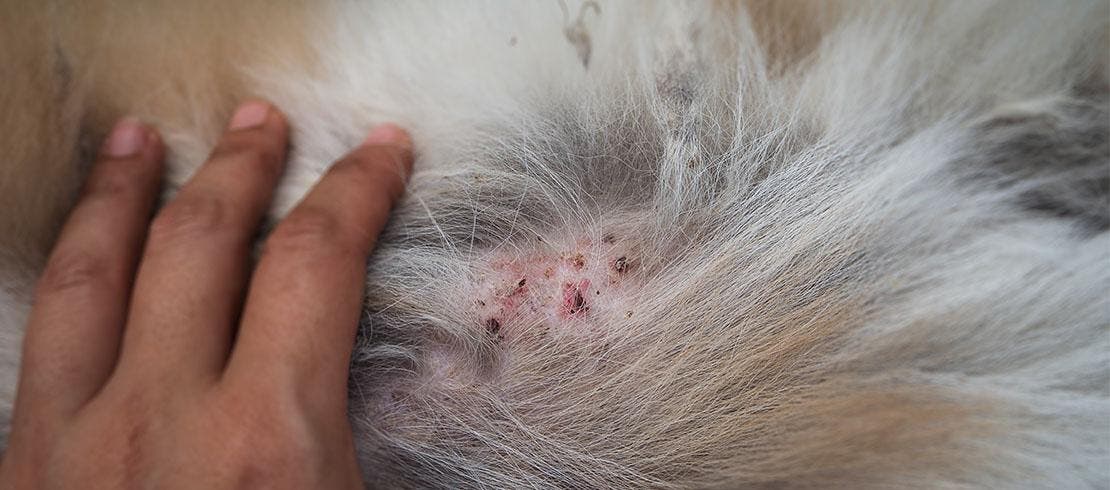As if flea bites were not itchy enough, some dogs and cats might also be allergic to fleas, causing them intense irritation.
You may not have heard of it but flea allergy dermatitis (FAD) is one of the most common skin diseases in animals1. Scratch your curiosity itch to discover more about this condition and if your cat or dog is allergic to fleas.
What is flea allergy dermatitis?
Flea allergy dermatitis, or FAD, is a skin allergy to a flea bite, which affects cats and dogs. However, it is not the flea they are allergic to; in fact, it is a reaction to certain proteins in the flea’s saliva that causes intense irritation to your pet’s skin.
Dogs and cats come into contact with the saliva allergen when fleas bite and feed on them. Just a single bite can lead to severe skin discomfort, making it even more important to help keep your pet free from fleas.
Which pets are particularly at risk?
Any adult dog or cat of any breed can have FAD.
Dogs tend to develop clinical signs of FAD between the ages of one and three years and it’s much less common in dogs under six months. Once diagnosed with FAD, dogs have it for life.
FAD is prevalent when fleas are around. The warmer summer weather was once an indicator that ‘flea season’ had arrived. Now, due to modern houses with central heating, a flea infestation can occur throughout the year, putting pets with FAD at risk unless an appropriate preventative treatment is given.
Signs of flea allergy dermatitis
It’s difficult not to notice if your dog or cat has FAD. This allergy doesn’t cause the normal everyday itch; instead, your pet will be scratching as though their life depended on it.
A never-ending itch is the most common sign of FAD but, if you’re unsure, signs also include:
- Excessive grooming – your dog or cat grooming more than normal, chewing and licking their skin and scratching themselves on objects
- Restless behaviour – your pet is unable to relax, appearing uncomfortable
- Visible fleas – a flea on your pet, or flea faeces, known as flea dirt, which appears as black spots on the skin of the animal and turns into a rust-coloured substance when wet
- Unusual odour – you notice a smell from their skin, which could be a result of a secondary skin infection
- Changes in skin texture – areas of your pet’s skin feel different from normal. In some cases, your pet may display a type of skin lesion called miliary dermatitis, which are skin spots that feel similar to millet seeds
- ‘Hotspots’ – in both dogs and cats, you should also look out for red and moist areas of skin called ‘hotspots’, which indicate a secondary bacterial or fungal infection due to extreme scratching. Unfortunately, the itchy feeling at these spots will be even more intense than first signs of FAD.
Although FAD is the same condition in both dogs and cats, it can appear differently on their skin.
- Flea allergy in dogs – dogs with the condition tend to lose hair in patches, while their skin will be red and can appear thicker than normal caused by excessive scratching. These signs may occur at the lower back area, including the base of the tail and may also appear on the thighs and belly.
- Flea allergy in cats – an allergic cat may also display signs of hair loss as a result of excessive licking. You might notice thinner hair at the tail base, on the belly, and hind legs. There may also be small scabs in these areas and around the back of the neck.

How is FAD diagnosed?
If your dog or cat is scratching or grooming themselves excessively, it’s a good idea to visit the vet. You may not have noticed any fleas on your pet but that doesn’t mean they’re not there. Although in some cases, pets with FAD often groom themselves so much they actually remove fleas from their coat. Even so, the allergic reaction can hang around for weeks. Plus, without a preventative treatment, there is a possibility of re-infestation.
Excessive scratching may also be a result of another health problem, so it’s important to visit the vet to get the right diagnosis and treatment.
Your vet will determine whether your pet has FAD by initially looking for fleas in their fur and on their skin. But, as pets will often remove them through grooming, the vet may need to carry out skin tests to rule out other causes.
Flea treatment is often prescribed for any pet with an itchy issue because fleas can exacerbate any skin problem, not just FAD. A positive response to flea treatment can also help to confirm diagnosis of fleas in a pet with FAD.

Treatment for Flea Allergy Dermatitis
If your pet is diagnosed with FAD, always follow your vets advice, this may include some of the following steps to help get your pet back to their usual healthy happy selves.
Step 1: Treat your dog or cat against fleas
Treatment against fleas is essential to bringing an end to your pet’s misery. An effective flea control product will help to reduce your dog or cat’s exposure to flea saliva.
There are many different flea treatments available. Flea treatments that kill fleas through contact do not require the flea to bite before they are affected by the treatment.
This type of treatment is available as a monthly topical product, such as Advantage Spot-on flea treatment, or as a flea collar, like Seresto Flea and Tick Control collar, which provides up to eight months of protection from these parasites. Both products are available for dogs and cats.
The Seresto Flea and Tick Control Collar:
- is long-lasting, providing a convenient way to help keep your pet’s FAD at bay
- contains the active ingredient, imidacloprid, to kill fleas through contact without the need for them to bite your pet
- protects your pet’s immediate surroundings against flea larvae development
- is easy to use, you just put it on around their neck like a normal collar

Step 2: Soothe the itch
Once flea treatment has been given, your vet will then relieve the desperate itch.
If your pet has picked up a secondary infection as a result of scratching and biting their skin to relieve their allergy symptoms, the itching will have become even more intense. To tackle this, your vet may prescribe antibiotics.
Your vet may also recommend medication to directly ease and soothe your pet’s inflamed skin.
Step 3: Treat your home against fleas
To help prevent reinfestation, you will need to ensure your home is free from fleas, as well as your pet.
When your pet has fleas, the adult fleas feeding on them make up a small fraction of the infestation, as there will be flea eggs and immature life stages hidden in carpets, soft furnishings and cracks in the floorboards throughout your house.
You can remove fleas from your home with these steps:
- Regularly clean your bedding and your pet’s bedding on a hot wash
- Vacuum your house frequently, paying particular attention to your pet’s favourite areas and under furniture
- Vacuum or clean cushion covers on your couch
- Regularly empty your vacuum cleaner and, for bagless vacuums, clean the cylinder where the dust collects to fully remove fleas from your home
- Finally, you may want to finish with a household flea spray to prevent the development of any flea eggs and larvae you have missed, or are hiding in hard-to-reach areas
Get more help to de-flea your home.
Step 4: Avoid irritating pet flea sprays and shampoos
If you are thinking of using a topical flea treatment to rid your dog or cat of fleas, speak to your vet first. When skin is already inflamed, shampoos and sprays designed to repel or kill fleas contain chemicals that could easily irritate skin further. Even ‘natural’ remedies such as essential oils can make the situation worse.
Step 5: Attend check-ups after treatment
When your pet has suffered an infection, (as advised by your vet) it is important to attend the check-up appointment following treatment to ensure the antibiotics are working and the infection has cleared.
References:
1 Small animal dermatology, 4th edition, 2017
Use Medicines Responsibly.
Seresto Flea and Tick Control collar contains imidacloprid and flumethrin [NFA-VPS]. Further information is available from the datasheet at www.noahcompendium.co.uk or on request. The Bayer cross is a Registered trademark of Bayer AG. Seresto, Elanco and the diagonal bar logo are trademarks of Elanco or its affiliates. Elanco UK AH Ltd., Form 2, Bartley Wood Business Park, Bartley Way, Hook, RG27 9XA. Tel. 01256 353131.
